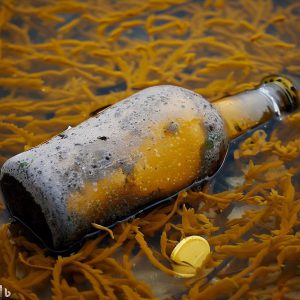It has been 8 months since Hurricane Ian, which came with an elevated number of cases of Vibrio vulnificus, or “flesh eating bacteria”, in Lee and Collier Counties. A new study from Florida Atlantic University Harbor Branch Oceanographic Institute suggests need for concern about the association between Vibrio species and Sargassum, particularly concerning as an unprecedented mass migrates towards Florida and Carribean Coastlines. According to the latest report from the University of South Florida Satellite-based Sargassum Watch System (SaWS), the level of Sargassum is expected to decrease in the Gulf of Mexico starting this month, easing concerns for Southwest Florida Coastlines. But, that hasn’t stopped concern about Vibrio spp. from reaching this side of the state. With this post, I aim to summarize the results of the FAU Vibrio study.
Background
Some background is required to fully understand the results of this study. “Vibrio” is a genus of warm, saltwater bacteria, and even though it encompasses Vibrio cholerae (Cholera) and Vibrio vulnificus (“flesh eating bacteria”), not all species are toxic. Vibrio species are important in the marine nitrogen cycle and are found in many places in the marine environment such as estuarine sediments, macroalgae mats, and seawater. There is an inherent risk of exposure with any water-based activity in Florida. Visit the Florida Department of Health (FDOH) page on Vibrio vulnificus for best practices to keep yourself safe.
Study

DALL·E, June 6th, 2023.
The purpose of the FAU study was to evaluate the potential of the relatively unexplored genus, Vibrio, to cause disease. Ultimately, they studied three species: V. fortis, V. parahaemolyticus and V. alginolyticus. Of these, only V. parahaemolyticus could be labeled as “flesh eating”. Vibrio vulnificus, the species that caused infection in Southwest Florida following Hurricane Ian, was not examined. The scientists collected Vibrio species from different combinations of surfaces and environments, investigating 16 samples collected from, eel larvae, plastic, Sargassum, and the water column itself in the Tropical Atlantic, Sargasso Sea and Caribbean Sea. 14 out of the 16 samples tested could kill red blood cells, rupture cell walls and form biofilms on plastic and glass. Since plastic and glass can often be carried with Sargassum mats, the authors suggest there may be an increased risk for human exposure. See the FDOH Page on Sargassum for best practices to stay safe around Sargassum.
The authors also sequenced each sample’s DNA and looked for genes used by other pathogens to cause illness. Many—if not all—of the samples possessed a gene that either Cholera or V. vulnificus use when colonizing human intestines. It is important to note, however, that the presence of these genes does not mean the genes are active. Surprisingly little DNA is actually used by any organism. Did you know that the human body only uses 1.5% of our DNA? The other 98.5% are considered “non-coding regions”, which means they are present (and have been mapped by scientists) even though they aren’t used for anything. There is little explanation for the existence of these non-coding regions, except to reduce the chance that a mutation occurs in the vital 1.5% the DNA that we use! It is also worth noting that possessing a ‘harmful’ gene does not make an organism harmful. For example, while all samples had genes in common with Cholera, none had the gene that produced the Cholera toxin.
What wasn’t reported in this study was the concentration of Vibrio species collected from the environment. As mentioned in the background, Vibrio is ubiquitous in the marine environment. The rate of infection is dependent on environmental concentrations, and while this study provides information on presence, it does not report concentration levels. Because bacteria and DNA are so small, to run tests that are perceptible, scientists must increase their sample size by feeding and replicating the cells. The information the authors of this study present, therefore, is qualitative and not quantitative. It offers insight on possible mechanisms of infection, but does not make any conclusions about the rate of new infections.
Conclusions & Takeaways
- There are many Vibrio species in the marine environment, and not all are flesh eating!
- The study out of FAU showed that some Vibrio species can form films on plastic and glass. The authors deduced that since glass and plastic can be mixed in with sargassum, there might be an increased risk when handling Sargassum.
- The species of Vibrio tested in this study have some genes in common with harmful pathogens. The scientists explore these as pathways for causing illness, but no evidence was presented that these genes are active.
- The study does not include the concentration of Vibrio in the collection environment, a vital piece of information for predicting infection rates.
- Those most at risk to contract Vibriosis (or a Vibrio infection) are those who regularly consume raw seafood and those who handle estuarine life with a high injury rate (like catfish, oysters or crabs). This risk is increased when an individual is immunocompromised. Learn more about Vibrio infections in Florida.
- Sargassum, particularly beached Sargassum, has been getting a lot of negative attention in the media recently. It is important to remember that Sargassum is a natural part of the marine ecosystem that provides vital habitat to many of our favorite fish species. Learn more about the recent influx of Sargassum in Florida and the Caribbean.
A special Thanks to Dr. Ashley Smyth (UF/IFAS Tropical Research & Education Center), Holly Abeels (UF/IFAS Extension Florida Sea Grant Brevard County), Ana Zangroniz (UF/IFAS Extension Florida Sea Grant Miami Dade County) and Brandon Moody (Water Quality Manager for Charlotte County, FL) for their input.
 2
2
